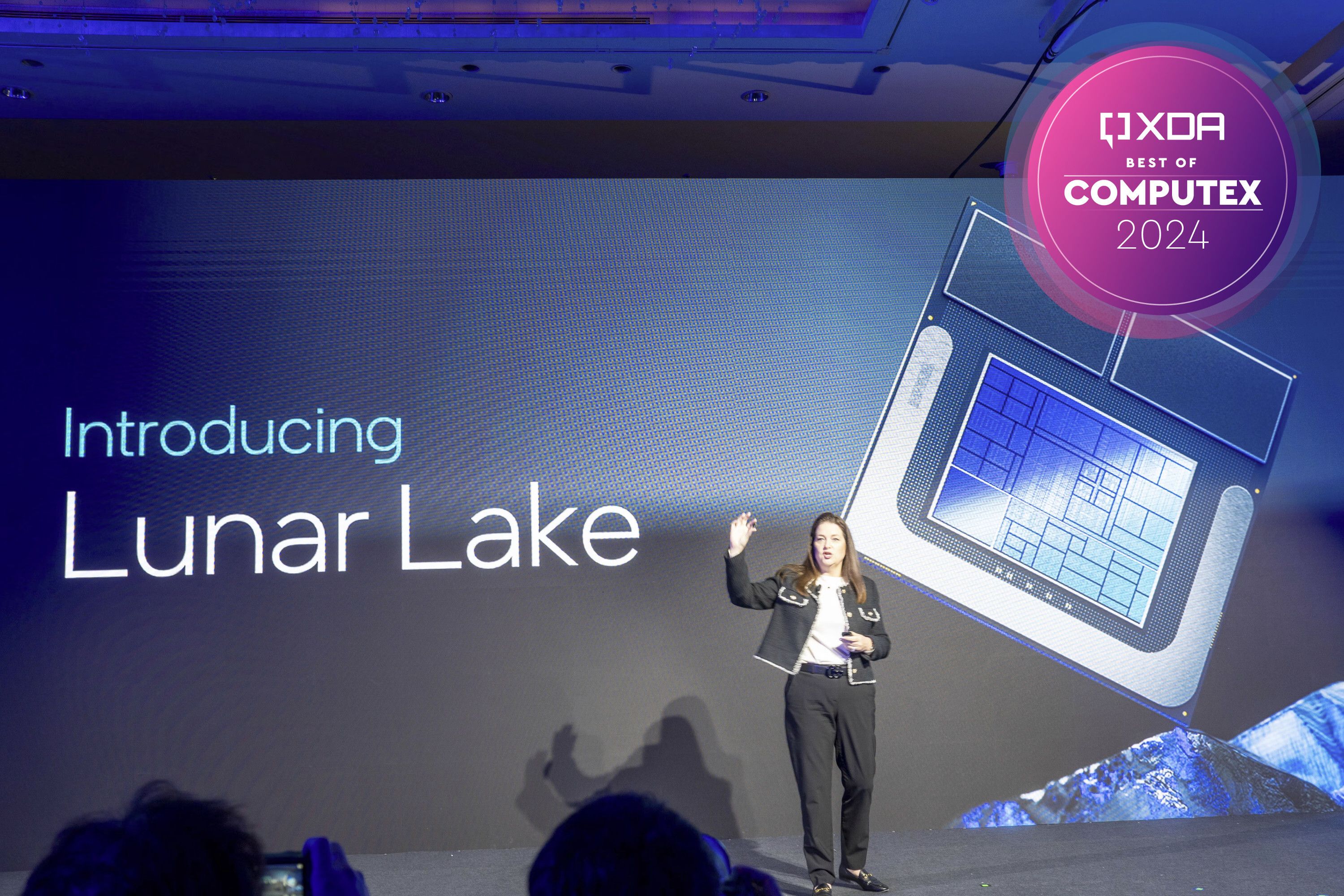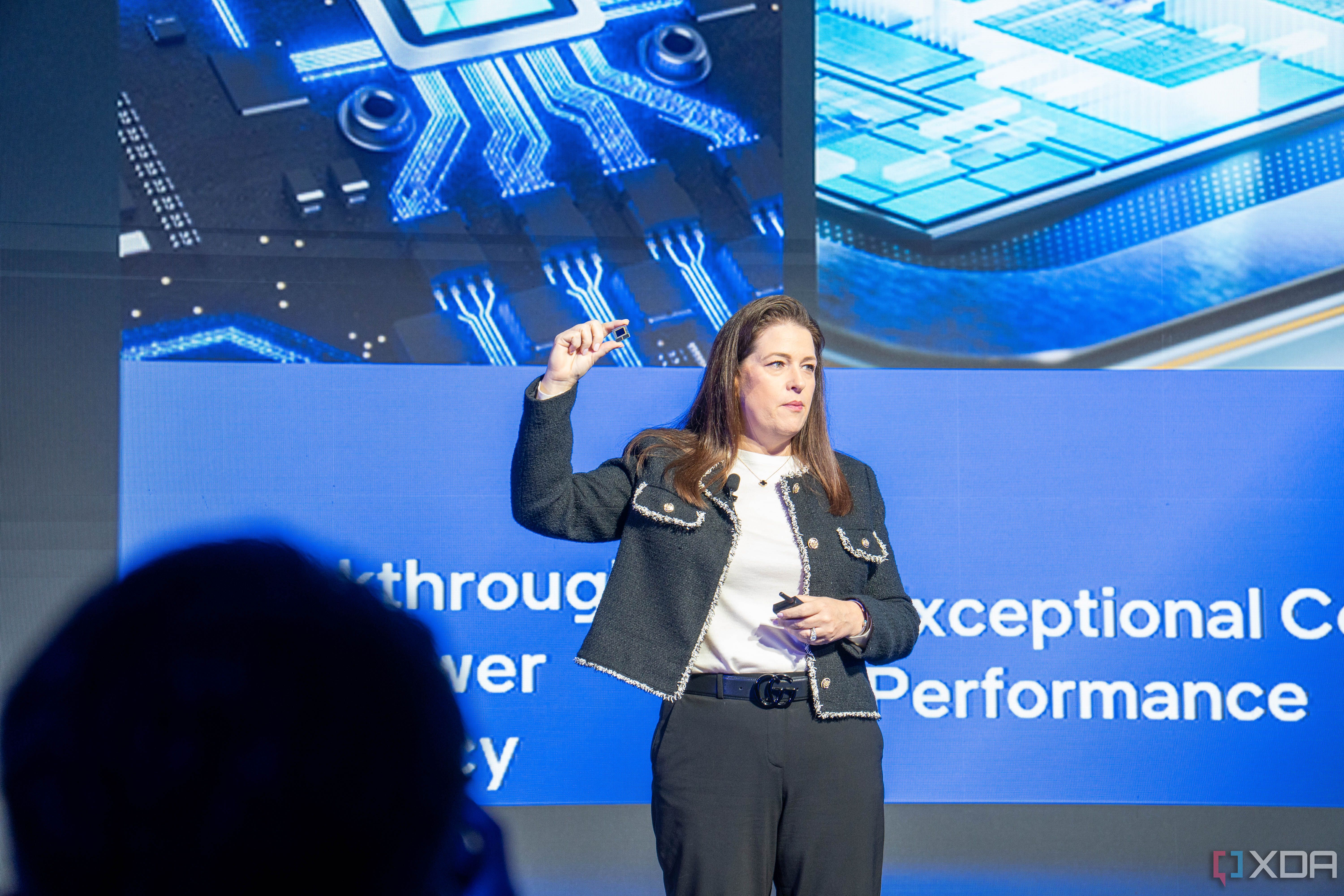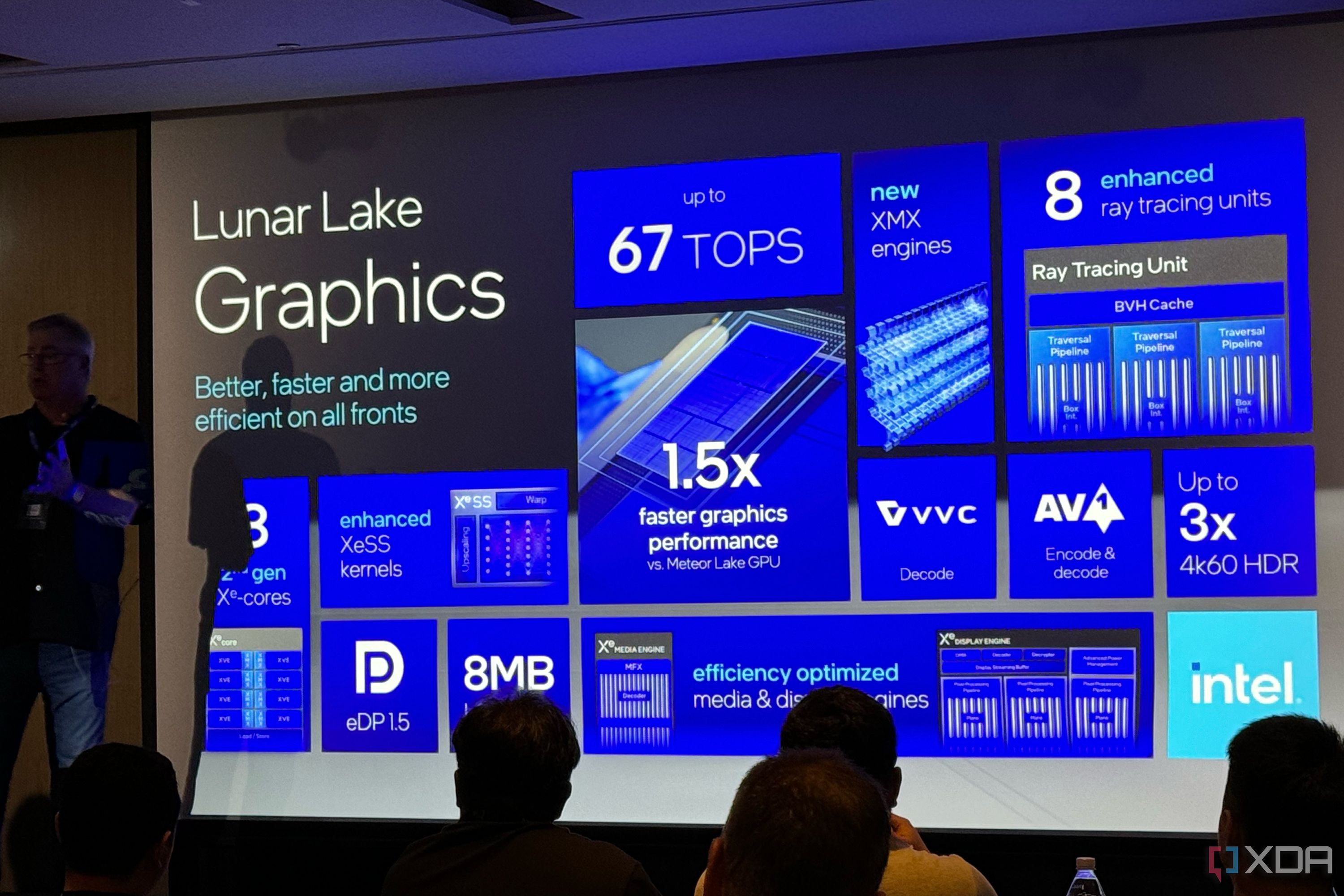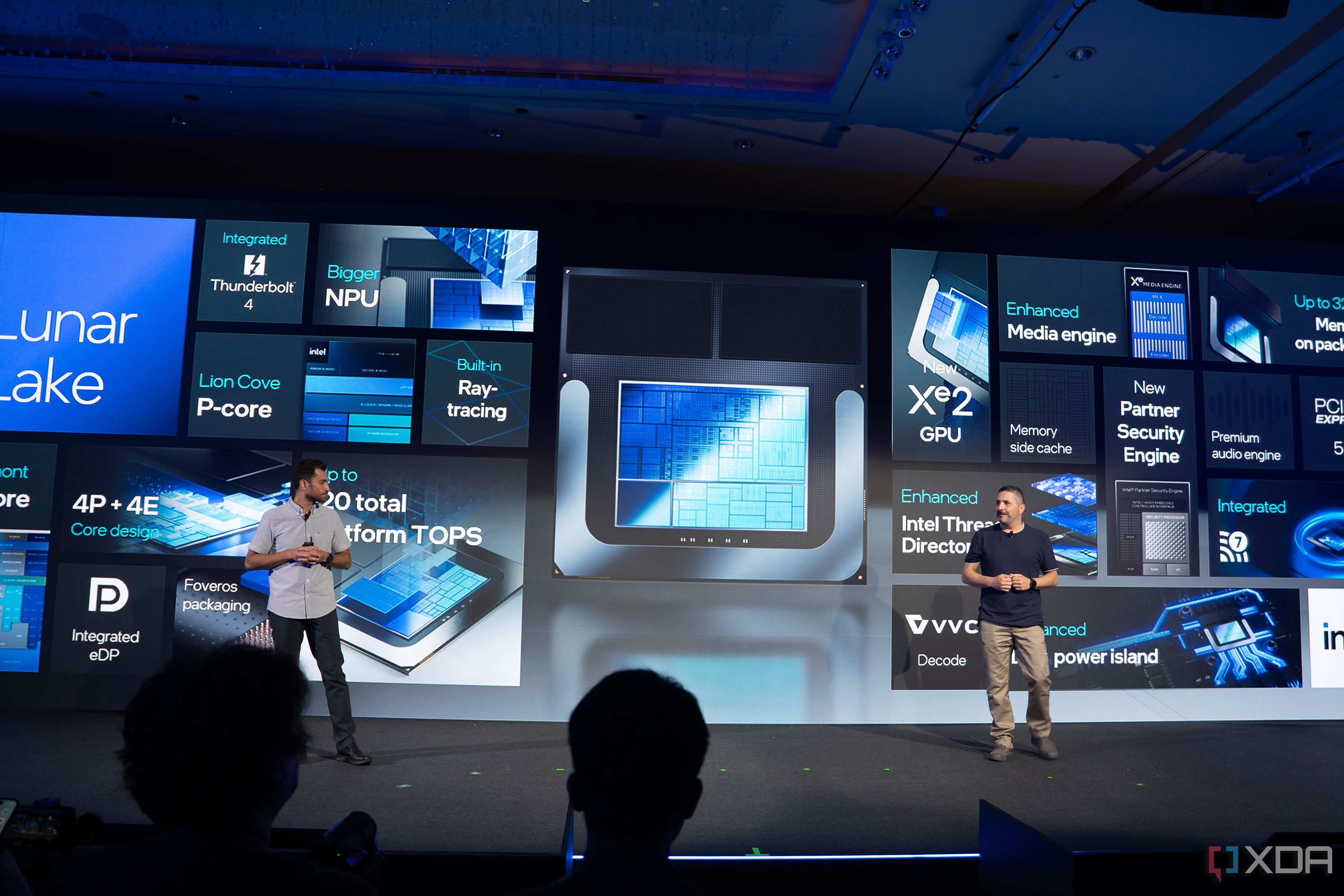[ad_1]
Intel’s next generation of mobile processors is codenamed Lunar Lake. The company is launching 9 processor SKUs, consisting of four Intel Core Ultra 5, four Intel Core Ultra 7, and a single Intel Core Ultra 9 CPU. All of these processors rock the same 4 P-cores and 4 E-core configurations but have varying speeds for the CPU and GPU, as well as some other specification variations. Speaking of which, Intel’s Xe2 GPU architecture will be present on the SoC, joining RAM, cache, an NPU, and the CPU itself. Here’s everything you need to know about Lunar Lake.
What is Intel Lunar Lake?
Next-next-generation
This is the codename for Intel’s next generation of low-power mobile chips. With the advancement of its E-core technology, Intel has developed a mobile-first architecture, replacing the existing U-series processors. Specifications of the new chips leaked before launch, but Intel trickled out data on all the new SKUs and the technologies powering them. Contrary to how processors have continued to evolve with more cores and threads, Lunar Lake processors will have eight cores across the board, consisting of four energy-efficient Skymont cores and four high-performance Lion Cove cores. Intel switched from a monolithic to a tile-based chip design with Meteor Lake and Lunar Lake will see the CPU, GPU, NPU, and cache all on the same package.
Intel’s 18A (1.8nm) manufacturing process was planned to be used for this architecture to get as much performance out of the processor, but the company will utilize its primary fab competitor TSMC with the N3B 3nm process node. We believe Intel will be moving back in-house with the next generation of mobile processors. Intel’s Lunar Lake will produce some powerful little chips for low-power and more affordable laptops. Similarly to how Apple designs its ARM-based processors, Intel will be moving RAM from the main PCB to the SoC, further increasing efficiency, which is paramount for mobile platforms such as laptops.
One omission from Lunar Lake CPUs is multi-threading support. Processors have been handling two executions in parallel but Intel will be removing this feature, citing power efficiency gains and the company states performance shouldn’t take a hit. The new Skymont E-cores should provide a much-needed performance boost without drawing more power compared to previous-gen Crestmont E-cores.
What Intel Lunar Lake CPUs are launching?
There’s an Intel Core Ultra for everyone
Intel will make 9 SKUs available for partners to include in their laptop portfolios. This provides ample choice, though all chips will have identical core configurations, PCIe lanes, RAM support, and maximum turbo power draw. Each processor will be able to boost up to 37W under the right conditions. Maximum P-core clock speeds start from 4.5GHz with the baseline Intel Core Ultra 5 chip to 5.1 GHz with the flagship Intel Core Ultra 9. E-cores are 3.5 GHz to 3.7 GHz, respectively. Intel Core Ultra 5 chips have access to 8MB of cache while Intel Core Ultra 7 and 9 series CPUs have 12 MB.
|
CPU |
Cores |
Speeds |
Smart Cache |
GPU |
PCIe |
RAM |
Power |
|---|---|---|---|---|---|---|---|
|
Intel Core Ultra 9 (288V) |
8 (4+4) |
P: ~5.1 GHz E: ~3.7 GHz |
12 MB |
Intel Arc 140V ~2.05 GHz |
8 (4+4) |
LPDDR5X-8533 32 GB/2R |
17-30 W |
|
Intel Core Ultra 7 (268V) |
8 (4+4) |
P: ~5.0 GHz E: ~3.7 GHz |
12 MB |
Intel Arc 140V ~2.0 GHz |
8 (4+4) |
LPDDR5X-8533 32 GB/2R |
8-17 W |
|
Intel Core Ultra 7 (266V) |
8 (4+4) |
P: ~5.0 GHz E: ~3.7 GHz |
12 MB |
Intel Arc 140V ~2.0 GHz |
8 (4+4) |
LPDDR5X-8533 16 GB/1R |
8-17 W |
|
Intel Core Ultra 7 (258V) |
8 (4+4) |
P: ~4.8 GHz E: ~3.7 GHz |
12 MB |
Intel Arc 140V ~1.95 GHz |
8 (4+4) |
LPDDR5X-8533 32 GB/2R |
8-17 W |
|
Intel Core Ultra 7 (256V) |
8 (4+4) |
P: ~4.8 GHz E: ~3.7 GHz |
12 MB |
Intel Arc 140V ~1.95 GHz |
8 (4+4) |
LPDDR5X-8533 16 GB/1R |
8-17 W |
|
Intel Core Ultra 5 (238V) |
8 (4+4) |
P: ~4.7 GHz E: ~3.5 GHz |
8 MB |
Intel Arc 130V ~1.85 GHz |
8 (4+4) |
LPDDR5X-8533 32 GB/2R |
8-17 W |
|
Intel Core Ultra 5 (236V) |
8 (4+4) |
P: ~4.7 GHz E: ~3.5 GHz |
8 MB |
Intel Arc 130V ~1.85 GHz |
8 (4+4) |
LPDDR5X-8533 16 GB/1R |
8-17 W |
|
Intel Core Ultra 5 (228V) |
8 (4+4) |
P: ~4.5 GHz E: ~3.5 GHz |
8 MB |
Intel Arc 130V ~1.85 GHz |
8 (4+4) |
LPDDR5X-8533 32 GB/2R |
8-17 W |
|
Intel Core Ultra 5 (226V) |
8 (4+4) |
P: ~4.5 GHz E: ~3.5 GHz |
8 MB |
Intel Arc 130V ~1.85 GHz |
8 (4+4) |
LPDDR5X-8533 16 GB/1R |
8-17 W |
Two GPUs are present, consisting of the Intel Arc 140V for the Intel Core Ultra 7 and 9 CPUs and the Intel Arc 130V for the Intel Core Ultra 5 range. LPDDR5X-8533 is supported across the board, though some CPUs have one rank and not two, limiting capacity to just 16 GB. Four PCIe 5.0 lanes are available with three integrated Thunderbolt 4 ports and Wi-Fi 7. These chips will be fully kitted out with everything you’d expect from a laptop in 2024.
New Intel Battlemage GPU and NPU
High-fidelity gaming and AI
Intel is using GPUs with improved integrated graphics capabilities, based on the architecture codenamed Battlemage. This integrated GPU has 8 second-gen Intel Xe cores. To help support high-fidelity gaming, Intel has packed in 8 ray tracing cores. Making use of the GPU and NPU for AI workloads, Intel-powered laptops will be able to better make use of available battery life by offloading specific tasks to various parts of the SoC. Intel is boasting some serious throughput improvements with this generation of Core Ultra chips and Xe Super Sampling (XeSS) will ensure you’re hitting high frame rates in demanding games.
Interestingly, the new integrated Intel Arc GPU is the first DirectX 12 Ultimate graphics processor to leverage LPDDR memory on the same package. 64 vector engines and 8 MB of cache will keep the display busy with plenty of rendered frames. One can expect to see considerable power savings with the integrated graphics, similar to what Apple offers with its M series of chips.
When will Luna Lake-powered laptops be available?
Sooner than you think
Lunar Lake is launching now and you can expect to see the first laptops arrive later this month. Intel partners will be announcing new platforms with the new Lunar Lake CPUs in the coming days, so be sure to remain tuned to our feeds as IFA progresses.
[ad_2]
Source link




